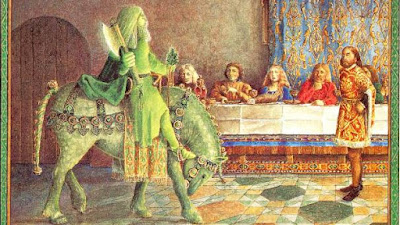The basic story: The poet
links Arthur’s kingdom to ancient Troy, suggesting that Arthur is descended from ancient
(and noble) stock. Then the action switches to Christmas games at Camelot,
where lo and behold, a Green Man storms the castle riding a tremendous green
horse. He challenges the knights to a contest: he will allow any man one chance to chop off his head, and if
he isn’t killed by the blow, the Green Knight gets to give a blow in return. No
one takes him up on this offer, and Arthur, humiliated, agrees to do it
himself. But Gawain, one of the younger knights, agrees to take his place and
slices off the Knight’s head. However, the Knight merely picks it up and says,
“see you in a year!”
Answer TWO of the
following questions for Monday. To get full credit for this assignment, be sure
to do the following: (a) answer each question in a few sentences, (b) be
specific—don’t just give a generic answer, and (c) if possible, quote part of
the book to support your ideas.
Q1: How is the court of
Camelot described/characterized by the poet? What kind of place is it? Is it an
idealized place of wonder and beauty, or is it a realistic kingdom of
debauchery and disorder?
Q2: Discuss some detail of
the poem’s description of the Green Knight. What stands out the most about him?
Why does the poet spend so much time—almost two entire pages—just describing
him? What might he want us to see/understand about his appearance in the hall?
Q3: According to the poem,
why does the Green Knight come to challenge Arthur and his court? By barging in
like this (and on a horse, no less), he’s breaking the laws of chivalry and
being quite disrespectful. What would make him act so flagrantly toward the
greatest king in the land?
Q4: Sir Gawain and the
Green Knight employs a poetic structure known as the “bob and wheel,” which
ends each of the stanzas. As the translator explains, “[it is] a short phrase
of two words containing one stress, the bob, followed by a four-line rhyming
quatrain made up of three-stressed lines” (xxiv). The translator doesn’t always preserve this
perfectly, but you can see it here from page 3:
to his great content
(the bob)
War, reprisal, exploit
have happened here at
times.
Joy and disaster
have often taken turns
(the four-line wheel).
Discuss how at least one
of these bob and wheels function in the poem. Why are they here? Do they break
up the story? Change the meaning? Offer a different perspective? How does it
read/sound compared to the lines that precede it?








.jpg)